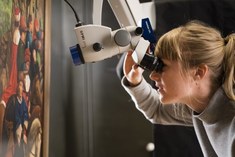Impact success story: Art sciences
In the Adoration of the Mystic Lamb, the masterpiece of the fifteenth-century painter Jan van Eyck, one can read almost the entire history of Western Europe.
The panels of the Ghent Altarpiece have been restored since 2012. Professor of Art Sciences Maximiliaan Martens calls this gigantic work the ‘second scientific restoration’ (the first, which was much more limited, took place in the 1950s). For this restoration, an interdisciplinary team of restorers, art historians and natural scientists worked together to find solutions to the problems they uncovered - almost literally.
Standard in conservation
The research team of Maximiliaan Martens has been focusing for many years on the preservation and management of our artistic heritage. This encompasses many issues, from conservation, to restoration and purely art-historical aspects. Today there is a lot of overlap with archaeology, natural science research methods and object research. So there is much more interdisciplinary collaboration, including with the fields of analytical chemistry and image processing. This interdisciplinary collaboration is also expressed in the methodology used for the restoration and removal of overpainting on the Ghent Altarpiece.
Ghent University researchers have also set a new standard for conservation. Overpainting is now being studied by visual observation, with the restorers looking at every square millimetre under a stereo microscope. If the layering is too complex, they move to 3D high resolution microscopy. This provides insight into the different layers without having to resort to traditional sampling. This method was invasive and even damaged the work. Though 3D microscopy does not yet completely exclude sampling, it does reduce it by 80%. That’s perhaps the most important contribution from Ghent University.
Uncovering and interpreting hidden layers
These new techniques provide much more insight into the layers, but also into the state of preservation of the underlying layers. This offers many new possibilities for restorers and art scientists. “By examining the very complex layers of the painting on the panels using the most advanced scientific techniques in the field of imaging and analysis, we see that thorough interventions have taken place since the sixteenth century and perhaps even earlier. Thus, overpainting. One of the most spectacular discoveries has been that the lamb itself had a totally different expression. The question now is of course: what does that mean? The lamb was not damaged. So there was no reason from a conservatory point of view to correct it. Could it have something to do with the sixteenth-century perception of how the symbol of Christ is represented here? What I think it has to do with is what we call decorum, the dignity of representing the Christ figure or Christ symbol. The anthropomorphic head with a penetrating look was probably no longer considered worthy in the context of the Reformation and the Counter-Reformation and was therefore painted over. In other words, even in that overpainting, we can derive all kinds of levels of meaning. We tend to view a painting in a museum as a static object.”
With this restoration of the Adoration of the Mystic Lamb, we begin to realise more and more that paintings have a life and change in view and meaning. This teaches us a great deal about our own history and I think that in itself also has societal relevance.
The work of Maximiliaan Martens and his colleagues is being reproduced worldwide. High resolution 3D microscopy and macro-xrf are now important tools that allow restorers to go much further than before. Even the professional ethics of restoration have begun to change through this project.
“Ten or even five years ago, most would have argued in favour of leaving overpainting to avoid taking the risk of scratching away too much. Now we can visualise everything, and we know what’s underneath the different layers. When we remove the overpainting, we see that the quality of what has been preserved is pure Jan van Eyck.”
Knowledge sharing through exhibitions
Maximiliaan regularly participates in exhibitions and this is squarely within the tradition of the department. There is currently a new exhibition that will be called ‘Van Eyck. An optical revolution.’ It will start in February 2020 and run until the end of April of the same year in the Museum of Fine Arts in Ghent. The outer shutters of the Adoration of the Mystic Lamb will be shown separately for the first time and in a way that allows visitors to see all the details up close. The shutters will be shown alongside a large number of other works by Van Eyck and at the same time together with contemporary Italian, German and French art to show how Van Eyck fits into his time. The influence of Van Eyck’s optical revolution on the subsequent generations will also be shown and explained.